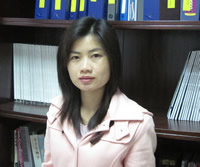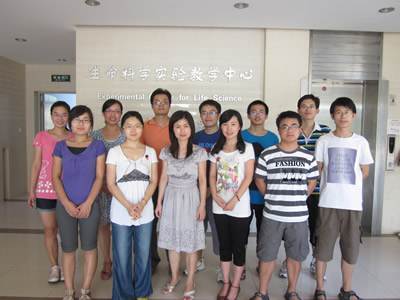 | 赖玉平教授 赖玉平教授2001年毕业于华东师范大学,2005 -2006年为美国国家卫生研究所(NIH)过敏与感染性疾病研究所(NIAID)联合培养博士研究生,2006-2010年在美国加州大学圣地亚哥大学医学院皮肤学系做博士后研究。赖玉平教授的主要研究方向为皮肤免疫学,目前本课题组正与美国、韩国等国家的科学家合作,已经在Nature Medicine、Immunity、PNAS、Molecular Microbiology等SCI杂志上发表论文22篇,申请专利4项。 |
学术团队
研究骨干
赖玉平 教授
吴叶林 助理研究员
博士研究生
李冬青 蒋子威 李长伟 全艳春
硕士研究生
李之珩 雷虎 张甜 王玥 李红泉

研究方向
皮肤免疫学 炎症对受损组织的正常修复至关重要。然而,持续的、过度的炎症反应会引起免疫损伤以及自身免疫性疾病。因此,本课题组以皮肤免疫炎症应答为研究对象,与美国、韩国等国家的科学家合作‚研究重点包括:1)皮肤感染、损伤后炎症的发生机制; 2)皮肤共生菌对伤口炎症应答的负调控机理;3)Th17细胞因子调节伤口愈合的分子机理;4)糖尿病皮肤伤口难愈合导致皮肤溃烂的分子机制;5)REG3A调节银屑病表皮层增生的分子机制。
主要主持科研项目
项目号 | 项目名称 | 项目来源 | 资助金额 | 起止时间 |
NSFC 81072422 | 皮肤共生菌调节TLR信号通路诱导抗菌肽抵制微生物感染 | 国家自然科学基金委 | 31万 | 2011-2013 |
NSFC31170867 | IL-17A调节REG3A促进伤口愈合的作用机理 | 国家自然科学基金委 | 60万 | 2012-2015 |
11QA1401900 | RegIII-gamma在伤口感染中的作用机理 | 上海市青年科技启明星项目 | 15万 | 2011-2013 |
12ZZ039 | REG3A调节非感染伤口TLR3-依赖型炎症发生的作用机理 | 上海市教育委员会科研创新重点项目 | 16万 | 2012-2013 |
SG0173 | S.epidermidis-related molecules which mediate inflammation and enhance AMP function | Johnson& | 131万 | 2010-2014 |
| 英才计划 | 华东师范大学 | 200万 | 2010-2015 |
申请专利
赖玉平,吴自荣,黄静,王林发,左翼,李骏. 一种高效表达重组人汗腺抗菌肽的基因工程菌及其构建方法和应用. 专利号: ZL 200510023674.4 (已授权).
Gallo RL, Nizet V, Cogen A, Lai Y. Antimicrobial and anti-inflammatory therapies and compositions. U.S.A. Patent No. US2010/0166708A1.
Lai Y, Gallo RL. An Unique TNF alpha Inhibitor to Suppress Inflammation while Enhancing the Innate Immune System against Viral or Microbial Infections. U.S.A. patent. UCSD Ref. No. SD2008-129.
Otto M, Li M, Lai Y, Villaruz AE, Cha DJ, Sturdevant DE. Gram-positive three-component antimicrobial peptide-sensing system. U.S.A. patent. Application No.60/930,709.
学术会议报告
2008. 10 American Society for Microbiology conference, beneficial microbes (San Diego, USA)
2009. 5 Plenary session in 2009 Society for Investigative Dermatology Annual Meeting (Montreal, Canada)
2009.11 Johnson & Johnson Skin Research Center, CPPW, a Unit of Johnson & Johnson Consumer Companies, Inc-Invited speaker ( Skillman, U.S.A.)
2010.5 Johnson & Johnson China Ltd. Worldwide EM Innovation Center -Invited speaker (Shanghai, China)
2010.10 中国微生物学会年会 (黄山,中国)
2011.9 Cold Spring Harbor Asia Infection & Immunity (Suzhou, China)
最新发表论文
Lai Y*, Li D, Li C, Muhleisen B, Radek KA, Park HJ, Jiang Z, Li Z, Lei H, Quan Y, Zhang T, Kotol P, Morizane S, Hata TR, Iwatsuki K, Tang C, Gallo RL. Activation of EXTL3-PI3K-Akt by REG3A regulates keratinocyte proliferation and differentiation after skin injury. Immunity. Accepted. (* Corresponding author)
Lai Y, Di Nardo A, Nakatsuji T, Leichtle A, Yang Y, Cogen AL, Wu Z-R, Hooper LV, Schmidt RR, von Aulock S, Radek KA, Huang C-M, Ryan AF, Gallo RL. Commensal bacteria regulate TLR3-dependent inflammation after skin injury.Nature Medicine.Covey Story. 2009, 15(12): 1377-1382.
Li M, Lai Y, Villaruz AE, Cha DJ, Sturdevant DE, Otto M. Gram-positive three-component antimicrobial peptide-sensing system. Proc Natl Acad Sci U S A. 2007, 104(22):9469-9474 (Co-first author).
Lai Y, Gallo RL. AMPed up immunity: how antimicrobial peptides have multiple roles in immune defense. Trends in Immunology. Feature Review. 2009, 30(3): 131-141.
Lai Y, Gallo RL. Commensal skin bacteria as the probiotic of the cutaneous immune response. Expert Rev. Dermatol. Editorial. 2010, 5(3): 251-253.
Lai Y, Gallo RL. Toll-like receptors in skin infections and inflammatory diseases. Infectious Disorders Drug Targets (Formerly ''Current Drug Targets - Infectious Disorders''). 2008, 8(3): 144-155.
Lai Y, Cogen AL, Radek KA, Park, HJ,Macleod DT, Leichtle A, Ryan AF, Di Nardo A, Gallo RL. Activation of TLR2 by a small molecule produced by Staphylococcus epidermidis increases antimicrobial defense against bacterial skin infections. Journal of Investigative Dermatology. 2010, 130(9):2211-2221.
Lai Y, Villaruz AE, Li M., Cha DJ, Sturdevant DE, Otto M. The human anionic antimicrobial peptide dermcidin induces proteolytic defence mechanisms in staphylococci. Molecular Microbiology. 2007, 63(2):497-506.
Lai YP, Peng YF, Zuo Y, Li J, Huang J, Wang LF, Wu ZR. Functional and structural characterization of recombinant dermcidin-1L, a human antimicrobial peptide. Biochemical and Biophysical Research Communications. 2005, 328(1):243-250.
Lai YP, Huang J, Wang LF, Li J, Wu ZR. A new approach to random mutagenesis in vitro. Biotechnology and Bioengineering. 2004, 86(6): 622-627.
Lai YP, Peng YF, Yu ZY, Huang J, Wu ZR. Cloning and expression of DCD-1L in Pichia pastoris. China Biotechnology. 2004, 2: 61-65.
Wang Z, Lai Y, Bernard JJ, Macleod DT, Cogen AL, Moss B, Di Nardo A. Skin Mast Cells Protect Mice against Vaccinia Virus by Triggering Mast Cell Receptor S1PR2 and Releasing Antimicrobial Peptides. Journal of Immunology. 2012, 188(1):345-357.
Leichtle A, Lai Y, Wollenberg B, Wasserman SI, Ryan AF. Innate signaling in otitis media: pathogenesis and recovery. Curr Allergy Asthma Rep. 2011, 11(1):78-84.
Wu YL, Huang J, Xu J, Liu J, Feng Z, Wang Y, Lai Y*, Wu ZR*. Addition of a cysteine to glucagon-like peptide-1 (GLP-1) conjugates GLP-1 to albumin in serum and prolongs GLP-1 action in vivo. Regulatory Peptides. 2010, 164(2-3):83-89. (*Co-corresponding author).
Feng Z, Lai Y, Ye H, Huang J, Xi XG, Wu Z. Poly (gamma, L-glutamic acid)-cisplatin bioconjugate exhibits potent antitumor activity with low toxicity: A comparative study with clinically used platinum derivatives. Cancer Science. 2010, 101(11): 2476-2482.
Leichtle A, Hernandez M, Ebmeyer J, Yamasaki K, Lai Y, Radek K, Choung YH, Euteneuer S, Pak K, Gallo R, Wasserman SI, Ryan AF. CC chemokine ligand 3 overcomes the bacteriocidal and phagocytic defect of macrophages and hastens recovery from experimental otitis media in TNF-/- mice. J Immunology. 2010, 184(6): 3087-3097.
Cogen AL, Yamasaki K, Muto J, Sanchez KM, Crotty Alexander L, Tanios J, Lai Y, Kim JE, Nizet V, Gallo RL. Staphylococcus epidermidis antimicrobial delta-toxin (phenol-soluble modulin-gamma) cooperates with host antimicrobial peptides to kill group A Streptococcus. PLoS One. 2010, 5(1): e8557.
Cogen AL, Yamasaki K, Sanchez KM, Dorschner RA, Lai Y, Macleod DT, Torpey JW, Otto M, Nizet V, Kim JE, Gallo RL. Selective antimicrobial action is provided by phenol-soluble modulins derived from Staphylococcus epidermidis, a normal resident of the skin. Journal of Investigative Dermatology. 2010, 130(1): 192-200.
Li M, Rigby K, Lai Y, Nair V, Peschel A, Schittek B, Otto M. Staphylococcus aureus mutant screen reveals the interaction of human antimicrobial peptide dermcidin with membrane phospholipids. Antimicrobial Agents Chemotherapy. 2009, 53(10):4200-4210.
Di Nardo A, Yamasaki K, Dorschner RA, Lai Y, Gallo RL. Mast cell cathelicidin antimicrobial peptide prevents invasive group A Streptococcus infection of the skin. Journal of Immunology. 2008, 180(11):7565-7573.
Li M, Cha DJ, Lai Y, Villaruz AE, Sturdevant DE, Otto M. The antimicrobial peptide-sensing system aps of Staphylococcus aureus. Molecular Microbiology. 2007, 66(5): 1136-1147.
Yao Y, Vuong C, Kocianva S, Villaruz AE, Lai Y, Sturdevant DE, Otto M. Characterization of the Staphylococcus epidermidis accessory gene regulator response: quorum-sensing regulation of resistance to innate host defense. The Journal of Infectious Diseases. 2006, 193(6):841-848.


